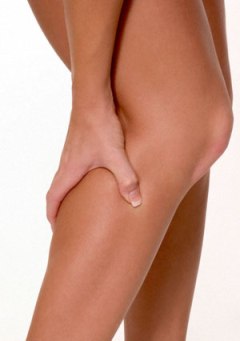 New Health Guide
New Health Guide
Feet numbness, calve aches and burning sensations in your legs can all be uncomfortable and sometimes painful experiences. In fact, many people seek medical attention when they experience these problems in a bid to get some form of relief. Unknown to many, leg pain, weakness, numbness, tingling and other symptoms affecting the leg or foot are not necessarily caused by the legs or feet, but lower back problems. In many cases, patients will not experience any pain or discomfort in the lower back but in the legs. Pressure or compression within the lower back’s nerve roots may cause the pain and discomfort. This may affect other nerves which go down to the lower body area causing these symptoms. It’s always good to seek medical attention because acting tough will not get you answers or relief.
 Many people experience feet and leg pains and this can be caused by various conditions. While some of these conditions may be temporary, others can be chronic and you need to seek proper medical evaluation from a doctor. Acute conditions like bone fractures, blood clots and sprains are possible causes and these can be treated.
Many people experience feet and leg pains and this can be caused by various conditions. While some of these conditions may be temporary, others can be chronic and you need to seek proper medical evaluation from a doctor. Acute conditions like bone fractures, blood clots and sprains are possible causes and these can be treated.
Plantar fasciitis is a condition that affects the plantar fascia which is a connective tissue that is located at the bottom of the foot. This condition is caused by inflammation mostly due to overuse. It’s most common amongst athletes and overweight patients. The condition brings about pain at the bottom of the foot and the heel. You can deal with the pain by wearing supportive footwear, losing weight or taking medication.
Arthritis tends to bring about joint aches, stiffness and swelling. The most common forms of arthritis are rheumatoid arthritis and osteoarthritis. These two conditions may cause pain, tenderness, stiffness and swelling in the feet and legs. The pain can be relieved by treating the individual forms of arthritis. Doctors may prescribe anti-inflammatory medication, cortisone injections, physical therapy, rehabilitation and other forms of treatment for chronic pain.
Neuropathy is nerve damage and it can cause pain, numbness and bring about tingling sensations within the feet and legs. The peripheral nerves are most affected and these can cause burning pains along with other symptoms. The condition can be managed by undergoing chronic pain rehabilitation programs, exercising mildly, taking medications as prescribed by the doctor and engaging in cognitive behavioral therapy.
Sciatica is known to cause pain from the buttocks all the way to the legs and toes. Most sciatica patients will recover without much treatment. However, if the pain lasts for more than 6 months, it is considered to be a chronic condition. Pain is dealt with through physical therapy, chronic pain rehabilitation, and interventional treatments such as nerve blocks or in some cases surgery.
Pregnant women often suffer from foot and leg problems, especially as they progress with the pregnancy. This is mostly related with weight and hormonal. Hormonal changes during pregnancy force the arch of the foot to compress causing a flat foot. This causes a strain within the leg muscles as they try to regain stability. Pain cramps in the legs are mostly caused by changes in the nerve volume or compression of the sciatic nerve.
Certain medical conditions can cause leg pain and one of these is fibromyalgia. This condition is accompanied by pain cramps in the lower part of the leg and restless leg syndrome as well. Conditions such as thyroid disease and multiple sclerosis can also cause leg and feet pains. There are medications such as statin drugs and diuretics that have been known to cause leg pains.
Leg and feet pains also may be caused by insufficient blood supply in the legs or claudication. In most cases, the patient will feel the pain when exercising or walking. There are various blood vessel conditions and some of these include: peripheral arterial disease (PAD) and deep vein thrombosis (DVT). PAD leg pain is often experienced when the patient is active and this means that the muscles need more blood than they are getting. DVT can bring about swelling and the leg can turn blue especially when there have been extended periods of rest.
This is a disorder that affects the peripheral motor and nerves which connect the spine to your internal organs, muscles and skin. The condition can make your legs and feet feel heavy, cause numbness and tingling. The patient may even not be able to feel sensations in the legs. This condition is mostly caused by diabetes and alcoholism.
Your muscles depend on the nerves which are supported by well balanced electrolytes such as magnesium, calcium, sodium and potassium. These electrolytes are meant to transmit signals which affect muscle function, the heart, nerves and even control the amounts of water in the body. Dehydration and medical conditions such as diarrhea or kidney diseases could affect the electrolyte balance and cause leg pain.
Pain in feet can also be caused by the following conditions:
Gout, bunions, sprains, strains, ingrown toenails, hammer toe, tendonitis, bursitis, fractures, juvenile rheumatoid arthritis, toxic synovitis, fibromyalgia and pes planus also known as fallen arches.
Pain in legs can also be caused by the following conditions:
Peripheral vascular disease, radiculopathy, charley horse, multiple sclerosis, spinal stenosis, pulmonary embolism, arterial embolism, varicose veins, shin splints, osteochondrosis, arterial sclerosis, Osgood-Schlatter disease, polio and others can cause leg pain.
The best way to ease leg and feet pain is by first identifying the cause. Straining physical activities can cause muscle fatigue and cramps leading to leg and foot pain. You can care for your legs and feet at home by:
Seek medical attention if: